-
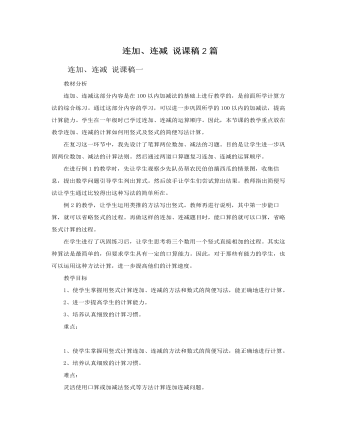
人教版新课标小学数学二年级上册连加、连减 说课稿2篇
教材分析连加、连减这部分内容是在100以内加减法的基础上进行教学的,是前面所学计算方法的综合练习。通过这部分内容的学习,可以进一步巩固所学的100以内的加减法,提高计算能力。学生在一年级时已学过连加、连减的运算顺序。因此,本节课的教学重点放在教学连加、连减的计算如何用竖式及竖式的简便写法计算。在复习这一环节中,我先设计了笔算两位数加、减法的习题。目的是让学生进一步巩固两位数加、减法的计算法则。然后通过两道口算题复习连加、连减的运算顺序。在进行例1的教学时,先让学生观察少先队员帮农民伯伯摘西瓜的情景图,收集信息,提出数学问题引导学生列出算式。然后放手让学生们尝试算出结果。教师指出简便写法让学生通过比较得出这种写法的简单所在。

人教版新课标小学数学二年级上册表内乘法(一) 说课稿
本课内容安排在学习了2—5的乘法口诀后,考虑到以后每次出现的口诀都比较多,而且较难记,所以学习乘加乘减也是为了帮助学生学习后面的乘法口诀。本课的教学内容有两个特点:一是让学生在实际生活中发现问题,为解决实际问题列出乘加、乘减的算式,并感受解决问题的策略和方法是多样的,通过对各种方法的比较能进一步加强对乘法意义的理解;二是第一册学生已经学过了连加、连减,它的计算顺序是从左到右,依次计算。本册的乘加、乘减都是只教学乘法在前,加、减法在后的题型,计算顺序同样是从左至右;但在教学中,不能让学生这样说,而必须是学生明确要先算乘法,教材的设计就正是如此,没把“先算乘法”作为运算顺序机械的灌输给学生,而是在现实的问题情境中联系解题策略,使学生依据问题的情理确定先算乘法,真正明白算理。根据教材特点,制定如下教学目标知识目标:在实际问题的情境中感受乘加、乘减算式的意义,能用不同的方法解决问题,知道乘加乘减算式的运算顺序。

人教版新课标小学数学二年级上册求一个数的几倍是多少 说课稿
1、教学内容:人教版实验教材二年级(上册)77页的例4。用乘法解决问题的教学渗透于掌握乘法口诀的教学过程中。教材在注重让学生通过活动探索、理解乘法计算的含义和方法的同时,渗透用乘法解决问题的教学。在教学过7的乘法口诀之后,安排了有关“倍”概念的教学,以及如何用乘法解决有关倍的实际问题。2、教材的重点和难点:教材的重点是理解“求一个数的几倍是多少”就是“求几个几是多少”。教材的难点是用乘法计算的解题思路。3、教学目标:1.进一步加深对“倍”的含义的理解。2.学会运用“求一个数的几倍是多少”的方法解决实际问题,构建解决“求一个数的几倍是多少”的问题的思维模式。3.初步学会分析数学信息与所求问题之间的联系,学会看线段图。
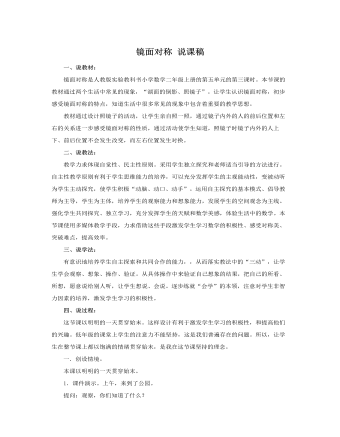
人教版新课标小学数学二年级上册镜面对称 说课稿
(1)让学生先想象以后,再发言。(2)组织两个学生亲自在全班进行验证。(3)组织学生汇报交流。通过学生的想象、验证,不但又一次让学生直观感受了镜面对称的性质,而且有利于学生的想象力和空间观念的培养。二.实践应用。1.进入第四个情境。配音:“咦,这是什么呢?”学生会很快答:是只蝴蝶。提问:怎样做才能看见一只完整的蝴蝶呢?学生回答后,课件演示一遍。要求以组为单位,拿出准备好的图片,进行照一照,能知道它们分别是些什么。指名学生上台演示。2.进入第五个情境。配音:“哪个是她们是在镜子里看到的样子呢?”指名选择,并说出为什么?3.玩游戏,比一比谁的反应快。游戏要求:老师做动作,要求学生做镜子里的动作。看谁反应快,谁能坚持到最后,谁就是胜利者。通过想一想、照一照、连一连、圈一圈等活动。加深了学生对镜面对称的性质的理解,使学生亲身体验了数学与日常生活之间的密切关系,培养了学生的空间想像力。
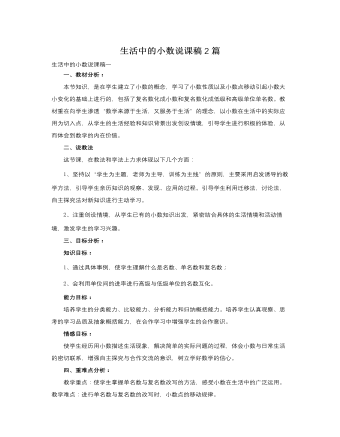
人教版新课标小学数学四年级下册生活中的小数说课稿2篇
一、教材分析:本节知识,是在学生建立了小数的概念,学习了小数性质以及小数点移动引起小数大小变化的基础上进行的,包括了复名数化成小数和复名数化成低级和高级单位单名数。教材重在向学生渗透“数学来源于生活,又服务于生活”的理念,以小数在生活中的实际应用为切入点,从学生的生活经验和知识背景出发创设情境,引导学生进行积极的体验,从而体会到数学的内在价值。二、说教法这节课,在教法和学法上力求体现以下几个方面:1、坚持以“学生为主题,老师为主导,训练为主线”的原则,主要采用启发诱导的教学方法,引导学生亲历知识的观察、发现、应用的过程。引导学生利用迁移法,讨论法,自主探究法对新知识进行主动学习。2、注重创设情境,从学生已有的小数知识出发,紧密结合具体的生活情境和活动情境,激发学生的学习兴趣。
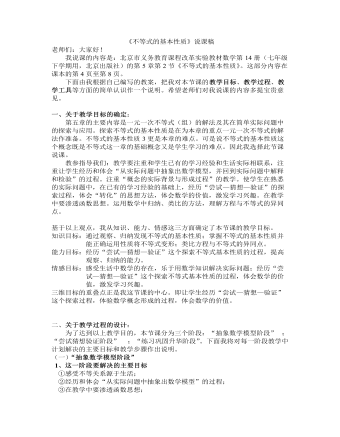
初中数学北京版七年级下册《不等式的基本性质》说课稿
一、关于教学目标的确定:第五章的主要内容是一元一次不等式(组)的解法及其在简单实际问题中的探索与应用。探索不等式的基本性质是在为本章的重点一元一次不等式的解法作准备。不等式的基本性质3更是本章的难点。可是说不等式的基本性质这个概念既是不等式这一章的基础概念又是学生学习的难点。因此我选择此节课说课。教参指导我们:教学要注重和学生已有的学习经验和生活实际相联系,注重让学生经历和体会“从实际问题中抽象出数学模型,并回到实际问题中解释和检验”的过程。注重“概念的实际背景与形成过程”的教学。使学生在熟悉的实际问题中,在已有的学习经验的基础上,经历“尝试—猜想—验证”的探索过程,体会“转化”的思想方法,体会数学的价值,激发学习兴趣。在教学中要渗透函数思想。运用数学中归纳、类比的方法,理解方程与不等式的异同点。
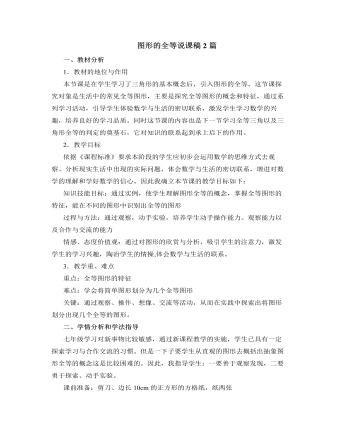
北师大版初中七年级数学下册图形的全等说课稿2篇
一、教材分析1.教材的地位与作用本节课是在学生学习了三角形的基本概念后,引入图形的全等。这节课探究对象是生活中的常见全等图形,主要是探究全等图形的概念和特征,通过系列学习活动,引导学生体验数学与生活的密切联系,激发学生学习数学的兴趣,培养良好的学习品质。同时这节课的内容也是下一节学习全等三角以及三角形全等的判定的奠基石,它对知识的联系起到承上启下的作用。2.教学目标依据《课程标准》要求本阶段的学生应初步会运用数学的思维方式去观察、分析现实生活中出现的实际问题,体会数学与生活的密切联系,增进对数学的理解和学好数学的信心。因此我确立本节课的教学目标如下:知识技能目标:通过实例,使学生理解图形全等的概念,掌握全等图形的特征,能在不同的图形中识别出全等的图形过程与方法:通过观察,动手实验,培养学生动手操作能力、观察能力以及合作与交流的能力
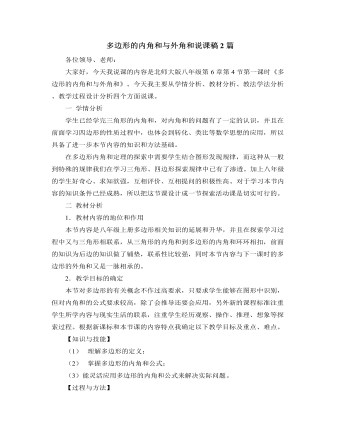
北师大版初中数学八年级下册多边形的内角和与外角和说课稿2篇
a.第127页随堂练习1第(1)题。b.一个多边形的边都相等,这是一个正多边形吗?c.一个多边形的内角都相等,这是一个正多边形吗?d.所以,一个相等,也都相等的多边形才是。(此检测主要是让学说出多边形和正多边形的定义,因为是在三角形、四边形的基础上,定义是一致的,所以不深究。在教材的处理上,把正多边形放在了前面,两个较为简单的概念放在一起,便于学生理解和掌握。)2.各组展示四边形的内角和的计算方法。3.各组展示五边形的内角和的计算方法。(由各组派代表上台板演,其它组补充,真正让学生动起来)4.各组选择前面最优的方法,口述六边形、七边形的内角和的算法。(以此上,学生可以利用对比的方法,选择作出过三角形的一个顶点的对角线的方法,让学生探索发现规律。)5.据此,你们认为n边形的内角和应该怎样计算。(注意n的条件)五、当堂训练。
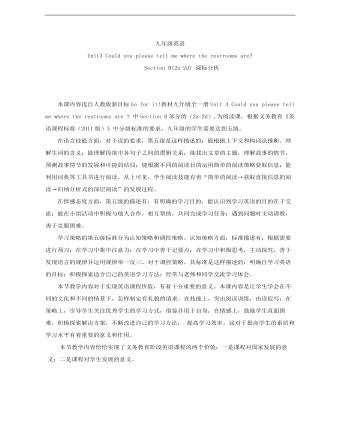
初中英语人教版九年级全册《Unit 3 Could you please tell me where the restrooms are》课标分析说课稿
学习策略的第五级标准分为认知策略和调控策略。认知策略方面,标准描述有:根据需要进行预习;在学习中集中注意力;在学习中善于记要点;在学习中积极思考,主动探究,善于发现语言的规律并运用规律举一反三。对于调控策略,其标准是这样描述的:明确自学习英语的目标;积极探索适合自己的英语学习方法;经常与老师和同学交流学习体会。

人音版小学音乐一年级上玩具兵进行曲说课稿
这就充分说明了别看低年级孩子年龄小,但相信只要通过仔细聆听,认真思考,低年级学生在他们的层面上也完全有能力感悟音乐的内涵所在。最后在孩子们充分发挥想象力后,教师再简单地揭示本课的主题以及作者和创作背景,尽可能地为每一位学生搭建一个展现自我风采的舞台。在感知《玩具兵进行曲》的基础上,再以 " 优化学习的方式,进行教学反馈。 " 让学生亲自体验创作运用多种不同的形式(如:合唱分组、舞蹈表演、乐器演奏等形式)对歌曲《玩具进行曲》进行分组表演的乐趣。在表现 " 玩具木偶 " 愉悦心情的同时,通过生生互动、师生互动、略带游玩式的教学形式,以次来培养学生对音乐的兴趣,把课堂又推向一个新的高潮。本课的设计力求能引起学生学习音乐的愿望,强化审美体验,给学生带来愉悦的教学方法。当然课的设计还存在着许多的不足,设计者渴望得到各位专家和老师的指点与帮助。同时希望引起对此问题的共同探究和研究,摸索出一套行之有效的教学方法。
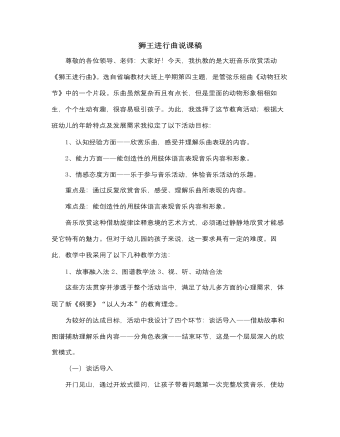
人音版小学音乐二年级下册狮王进行曲说课稿
接着,引导幼儿结合连环画完整欣赏音乐、根据情节匹配图谱、看图谱听音乐等形式加深对音乐的理解和记忆,使幼儿很好的从故事这块跳板转到对音乐的欣赏和感知上来,实现了视、听觉双重而完美的体验。最后,在充分感受乐曲的基础上我总结了进行曲的性质,并引出了乐曲的名字《狮王进行曲》,让幼儿对世界名曲的内容和名称有准确而全面的感知。(三)用动作创造性地表达乐曲的内容和形象。《纲要》中指出:幼儿艺术活动的能力是在大胆表现的过程中逐渐发展起来的,教师要培养幼儿表现自己情感和体验的能力。根据纲要精神我提供自由表演的机会,鼓励幼儿根据音乐内容大胆地用肢体语言表达自己的情感和想象,将幼儿对乐曲的感受和理解推向了高潮。结束环节的互动,使幼儿充分体验到了表演的成功和快乐。

中班音乐《“摇篮曲”与“进行曲”》说课稿
近代学习心理学的信息加工理论认为:熟悉程度过低的刺激,不易激发起主动探究、操作的行为。因此,在本次活动的选材和设计上,都努力确保幼儿对乐曲有充分的冗余度(熟悉程度)。《摇篮曲》是幼儿所熟悉的,小班时也欣赏过与本次活动选用的教材所类似的摇篮曲。德国作曲家勃拉姆斯于1868年创作的《摇篮曲》,乐曲采用大调式,3/4拍子,简单的主题充满了温和安详的情绪,表现了母亲对孩子深深的爱。《威风凛凛进行曲》这首进行曲因为它非常形象,非常有感染力,所以现在已经为许多国家军队仪式所采用。乐曲速度较快,是大调式2/4拍。它分三个部分,表现了热烈欢快的气氛和辉煌、庄严、壮丽的场面。“进行曲”音乐形象鲜明,节奏明显,在日常生活中幼儿也有精神饱满地列队、踏步、做操、开运动会等的体会,同时也具有一定的生活经验和感受音乐的经验,遵循以幼儿经验为基本出发点。

人教版高中政治必修3坚持先进文化的前进方向说课稿
教师点拨:是社会主义意识形态的本质体现,是全国人民团结奋斗的共同思想基础。④建设社会主义核心价值体系的要求设置探究问题:建设社会主义核心价值体系的要求有哪些?学生自主学习教材,得出结论板书:3建设社会主义核心价值体系的要求设计意图:在掌握了内容的基础上,这一部分知识的学习水到渠成。高举旗帜科学发展板书:1、中共引领文化前进方向的旗帜是——中国特色社会主义设置探究问题:高举中国特色社会主义伟大旗帜最根本的要求是什么?学生自主学习,回答问题板书:2高举中国特色社会主义伟大旗帜,最根本的是坚持中国特色社会主义理论体系。教师继续追问:这一理论体系的基本内涵是什么?能否举例说明这一理论体系有什么特点。学生讨论,教师点拨:这个理论体系,坚持和发展了马克思列宁主义、毛泽东思想,是马克思主义中国化最新成果。中国特色社会主义理论体系具有强大的生命力、创造力、感召力,是不断丰富和发展的马克思主义

人教版高中英语必修1Journey Down the Mekong说课稿
2. let the Ss complete the forms paragraph by paragraph. Purpose here is to help Ss to get the habit of reading a passage as a whole, and pay attention to the organization of the text, as a result the Ss will fully understand the whole passage.3. ask Ss to retell the passage with the help of the key words in the form.Since the Ss in the class are in different levels, so I let them to fill in the blank to understand the meaning of the words and phrases better. ( That’s all for the while-reading. Now let’s move to the fifth step.)Step V: Post-reading (10mins) ---DiscussionIn this part students are asked to discuss in groups and list Wang Kun’s and Wang Wei’s attitudes about the trip. After that, Ss are encouraged to express their attitudes with the whole class. Collect their answers and don’t forget to praise them even if their answers may not be perfect.In this activity, discussion provides a vivid and active learning environment for Ss to communicate in English with newly learned language items. (Finally it comes to the homework.)StepⅥ: Homework (1min)1. Ss are required to read the text again after class and figure out the meaning of some complex sentences.2. Do the exercises on P19; This can help Ss to consolidate what they’ve learnt and make preparation for the next lessonPart4. Blackboard design.(说板书设计)On the top, there is the title of this lesson. On the left, there are main ideas for each paragraph. On the right, there are some new words and expressions.Unit 3 Travel journalJourney down the MekongMain idea of each para.:Para1: deciding to take a great bike trip along the Mekong river.Para2: Different attitudes between Wang kun and Wang wei.

人教版高中英语必修4Body Language说课稿4篇
Textbook: Senior English for China (Book 4), by Liu Daoyi Time Allotment: 1 period (40 minutes)Date: March 20, 2014Teaching aids: blackboard, Multi-media, Power Point, chalk I. Text Analysis (教材分析)This unit is about body language, and the text selected in the reading part demonstrates the difference and similarity of body language in many parts of the world. Through learning this passage, students are required to raise their awareness of using body language in different parts of the world. As body language is closely related to our daily life, it is easy to arouse students’ interest in learning this text. Reading skills and speaking training are designed around the text.II. Teaching Objectives (教学目标)By the end of the lesson, students will be able to:1. Language Skill Objective(语言技能目标): develop reading ability (skimming and scanning)as well as speaking ability.2. Cultural Knowledge Objective(文化知识目标): know about the cultural differences of using body language.3. Affective Objective(情感目标): increase students’ awareness of using body language correctly in different cultures. III.Teaching Focuses and Difficulties(教学重点和难点)1. Teaching Focuses(教学重点): the difference and similarity of body language in many parts of the world.2. Teaching Difficulties(教学难点): develop students’ reading abilities of skimming and scanning and ask the students to show their opinions with fluent English.

人教版高中英语必修1Anne's best friend说课稿
Step 7 Language points 1.Vocabulary (1) go through (2) set down (3) a series of (4) on purpose (5) in order to (6)at dusk (7)entirely (8)face to face 2.Important sentences (1)…I’ve grown so crazy about everything to do with nature. (2)There was a time when … (3)I stayed awake on purpose until … (4)It was the first time … that I’d seen the night … (5)It’s no pleasure looking through … Purpose: 1.Master the required vocabulary and sentence structures. 2.Use them freely. Step 8 Consolidation 1.Find out the topic sentences 2.Retell the text according to the topic sentences Purpose: I want to know if my students understand the text. Step 9 Discussion Imagine you have to go into hiding like Anne and her family, what would you miss most? Giveyour reasons. Purpose: Train Ss’ oral English ability. Step 10 Homework Write an article on Friends. Purpose: 1. Improve the Ss’ writing ability. 2 Train the Ss’ ability of self—teaching and looking up information by themselves. Part 5 Blackboard design(说板书设计)Unit 1 Friendship Reading Anne’s Best Friend 1.Main idea of each paragraph: Para. 1 Anne made her diary her best friend. Para .2 Anne wrote her feelings in her diary. Para .3 Anne missed nature. Para.4 Anne saw the night face to face Para.5 Anne wanted to experience nature outdoors. 2.Listening: Exx.1 P3 3.Discussion: Exx.3 P3 Purpose: 1.Make Ss familiar with the passage 2.Make the design inductive, instructive and artistic.

人教版高中英语必修1English around the world说课稿
(3)v. 给:提出;展现,显现present sb. with sth. ; present sth. to sb. 把. . 交给;颁发;授予present sth. (for sth. )/present sth. to sb. e. g. Om his birthday, his friends presented him a collection of stamps. 在他生日时,他的朋友们送给他一套邮票作为礼物。The sword was presented by the family to the museum. 这家人把宝剑捐赠给了博物馆。The committee will present the final report to Parliament in June. 委员会将在六月向议会提交最后的报告。You need to present yourself better. 你需要更善于展现自己。It is essential that we present a united front. 至关重要的是我们要表现得更加团结。Step 4 ConsolidationT:Now that we have got a general idea of these words and phrases. Lets make up some sentences using them to master them. Suggested sentences:1. Your duties include typing letters and answering the telephone. 2. It is one of the greatest roles that she has played. 3. A large number of people have applied for the job. 4. The number of the panda is declining. 5. I'11 go there, even if I have to walk. 6. He came up to me to ask for a light. 7. The novel is about a family who can't communicate with each other. 8. He based his plan on interests of most people. 9. Why doesn't he make use of his singing talent?Step 5 Summary and homeworkT:Today we dealt with several new words and phrases. After class I hope that youcan read them again and again to keep them in mind. That's all for today. You aredismissed.

人教版高中英语必修1Nelson Mandela--A Modern Hero说课稿
In this step, give students a few minutes to read the passage . While they are reading, I will write some key words of the text on the blackboard. Then ask students to retell the passage according to the key words.By retelling, students can improve their ability of language organization and have an overall understanding of the article.Step 4 Group discussionIn this step, students will be divided into groups of 4 to discussion the following question: What qualities make a great person?After their discussion, invite a few groups to make a report to the class.This group discussion can practice students’ oral English and cultivate their abilities of cooperation and communication.Step 5. HomeworkLet students write a short passage to introduce a great person he or she admires.The homework can consolidate the knowledge the students have learned and cultivate their writing ability. Part 6 Blackboard Design(板书设计)That’s all my teaching procedures. Finally, I’d like to say sth about part 6 blackboard design. On the top is the title. On the left, there will be some new words and expressions. In the middle of the blackboard, I will write some useful sentence structures so that the students can know clearly what they’ve learned and then try to master the knowledge.OK. That’s all for my presentation. Thank you for your attention.

人教版高中英语必修2Computers说课稿3篇
一. 教材分析1. 本单元的中心话题是“计算机(Computers)”,内容涉及计算机的发展历史,计算机的应用等。本节课是该单元的第一课时,我将Warming up, Pre-reading and Comprehending这四部分整合为一节精读课。其中。Reading部分是题为WHO AM I?的文章,以第一人称的拟人手法介绍了计算机发长演变的历史和计算机在各个领域的应用,其主旨是表达计算机的发展变化之快以及在生活中用途之广。而Warming up部分以图片的形式展现了计算机的发展历程;Pre-reading中的问题和排序分别是为了预测语篇的内容和测试学生对计算机历史了解的情况;Comprehending则通过各项练习训练学生的阅读技能,从而加深对文章的理解。可见这几部分是一个有机的整体。2. 教学目标:1) 语言目标:重点词汇及短语:abacus, calculate, calculator, PC, laptop, PDA, robot, analytical, technological, universal, mathematical, artificial, intelligent, network, explore, in common, as a result.重点句子:a. My real father was Alan Turing, who in 1963 wrote a book to describe how computers could be made to work, and build a “universal machine” to solve any mathematical problem.

人教版高中英语必修2Cultural Relics说课稿2篇
Ⅲ. Analysis of the teaching material:The topic of this unit is cultural relics. Students are quite interested in topics about different cultures around the world. This is the second period of the whole unit. As a reading class, the passage mainly talks about the history of the amber room (how it was made, sent as a gift, lost and rebuilt).According to the new national curriculum, when teaching reading, much emphasis should be put on training the students’ reading skills.Ⅳ. Teaching objectives1. Language objectives:1) Students are required to master the key words and phrases occurred in the passage (e.g. amazing, decorate, belong, in return, less than etc.)2) Students are required to learn the attributive clause and acquire the sentence pattern.2. 1) Students are required to describe a certain thing by using the new sentence patterns.2) Students are required to master two kinds of reading skills—skimming and scanning, and learn to use them in their daily reading.3. 1) Students are required to know the history of the amber room.2) Students are required to appreciate cultural relics and understand the importance of protecting them.Ⅴ. Teaching important and difficult points1) the new words, phrases, and sentence pattern in the course of reading.2) Teaching difficult point: Help the students master two kinds of reading skills—skimmingand scanning and learn to apply them in daily use.Ⅵ. Teaching methods:Task-based method & Top-down model Ⅶ. Teaching aids: PPT, pictures, blackboard Ⅷ. Teaching procedure:

